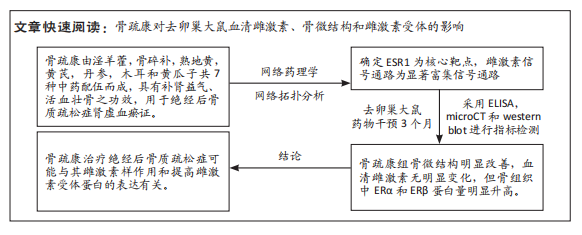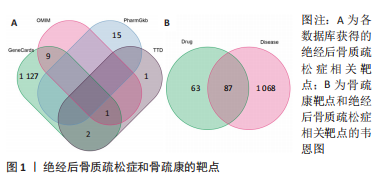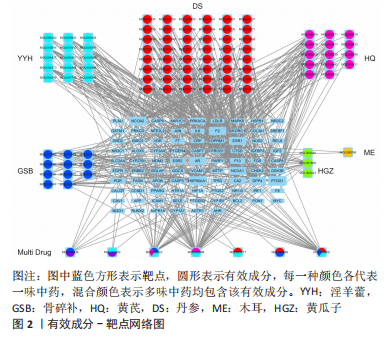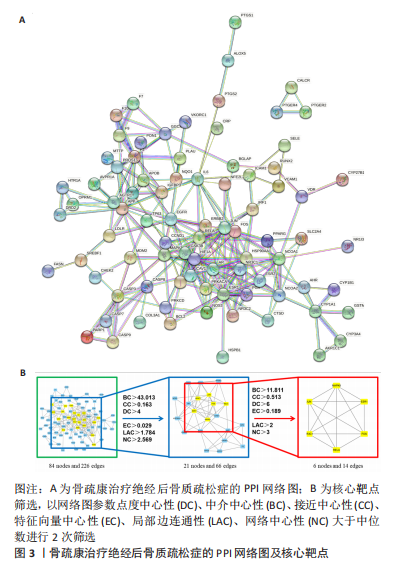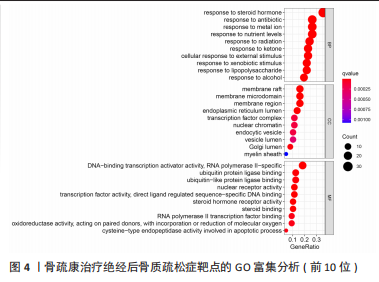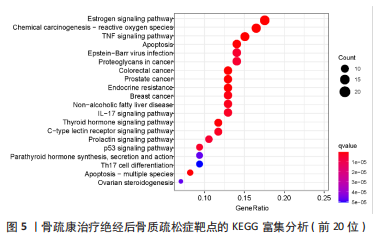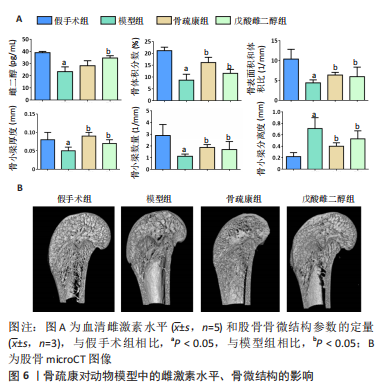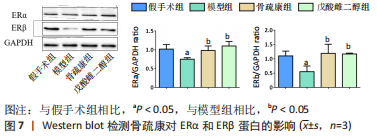[1] GKASTARIS K, GOULIS DG, POTOUPNIS M, et al. Obesity, osteoporosis and bone metabolism. J Musculoskelet Neuronal Interact. 2020;20(3):372-381.
[2] SLUPSKI W, JAWIEN P, NOWAK B. Botanicals in Postmenopausal Osteoporosis. Nutrients. 2021;13(5):1609.
[3] 中华中医药学会.绝经后骨质疏松症(骨痿)中医药诊疗指南(2019年版)[J].中医正骨,2020,32(2):1-13.
[4] 侍方,李欣,张蕊.骨疏康胶囊联合鲑鱼降钙素、戊酸雌二醇对绝经后骨质疏松患者的临床疗效[J].中成药,2020,42(12):3188-3192.
[5] CHAI S, WAN L, WANG JL, et al. Gushukang inhibits osteocyte apoptosis and enhances BMP-2/Smads signaling pathway in ovariectomized rats. Phytomedicine. 2019;64:153063.
[6] THOMPSON DD, SIMMONS HA, PIRIE CM, et al. FDA Guidelines and animal models for osteoporosis. Bone. 1995;17(S4):125S-133S.
[7] LI XL, WANG L, BI XL, et al. Gushukang exerts osteopreserve effects by regulating vitamin D and calcium metabolism in ovariectomized mice. J Bone Miner Metab. 2019;37(2):224-234.
[8] 杨骏杰,赵永见,王强,等.骨疏康颗粒对去卵巢小鼠体重、血清骨代谢指标和组织形态学的影响[J].中国骨质疏松杂志,2019,25(9):1212-1216.
[9] 郑志坚,舒冰,赵世天,等.骨疏康颗粒对去卵巢小鼠骨质疏松模型骨丢失和破骨细胞凋亡的影响[J].中华中医药杂志,2020,35(7):3647-3651.
[10] GE YW, FENG K, LIU XL, et al. Quercetin inhibits macrophage polarization through the p-38alpha/beta signalling pathway and regulates OPG/RANKL balance in a mouse skull model. J Cell Mol Med. 2020;24(5):3203-3216.
[11] VAKILI S, ZAL F, MOSTAFAVI-POUR Z, et al. Quercetin and vitamin E alleviate ovariectomy-induced osteoporosis by modulating autophagy and apoptosis in rat bone cells. J Cell Physiol. 2021;236(5):3495-3509.
[12] HUANG YY, WANG ZH, DENG LH, et al. Oral Administration of Quercetin or Its Derivatives Inhibit Bone Loss in Animal Model of Osteoporosis. Oxid Med Cell Longev. 2020;2020:6080597.
[13] SONG JE, TIAN J, KOOK YJ, et al. A BMSCs-laden quercetin/duck’s feet collagen/hydroxyapatite sponge for enhanced bone regeneration. J Biomed Mater Res A. 2020;108(3):784-794.
[14] LI X, JIANG Q, WANG T, et al. Comparison of the Antioxidant Effects of Quercitrin and Isoquercitrin: Understanding the Role of the 6’’-OH Group. Molecules. 2016;21(9):1246.
[15] CORDOBA A, MANZANARO-MORENO N, COLOM C, et al. Quercitrin Nanocoated Implant Surfaces Reduce Osteoclast Activity In Vitro and In Vivo. Int J Mol Sci. 2018;19(11):3319.
[16] WONG SK, CHIN KY, IMA-NIRWANA S. Quercetin as an Agent for Protecting the Bone: A Review of the Current Evidence. Int J Mol Sci. 2020;21(17):6448.
[17] YANG L, TAKAI H, UTSUNOMIYA T, et al. Kaempferol stimulates bone sialoprotein gene transcription and new bone formation. J Cell Biochem. 2010;110(6):1342-1355.
[18] LIU H, YI X, TU S, et al. Kaempferol promotes BMSC osteogenic differentiation and improves osteoporosis by downregulating miR-10a-3p and upregulating CXCL12. Mol Cell Endocrinol. 2021;520:111074.
[19] XIE B, ZENG Z, LIAO S, et al. Kaempferol Ameliorates the Inhibitory Activity of Dexamethasone in the Osteogenesis of MC3T3-E1 Cells by JNK and p38-MAPK Pathways. Front Pharmacol. 2021;12:739326.
[20] ADHIKARY S, CHOUDHARY D, AHMAD N, et al. Dietary flavonoid kaempferol inhibits glucocorticoid-induced bone loss by promoting osteoblast survival. Nutrition. 2018;53:64-76.
[21] LIANG G, ZHAO J, DOU Y, et al. Mechanism and Experimental Verification of Luteolin for the Treatment of Osteoporosis Based on Network Pharmacology. Front Endocrinol (Lausanne). 2022;13:866641.
[22] JING Z, WANG C, YANG Q, et al. Luteolin attenuates glucocorticoid-induced osteoporosis by regulating ERK/Lrp-5/GSK-3beta signaling pathway in vivo and in vitro. J Cell Physiol. 2019;234(4):4472-4490.
[23] ORSOLIC N, NEMRAVA J, JELEC Z, et al. Antioxidative and Anti-Inflammatory Activities of Chrysin and Naringenin in a Drug-Induced Bone Loss Model in Rats. Int J Mol Sci. 2022;23(5):2872.
[24] EASTELL R, O’NEILL TW, HOFBAUER LC, et al. Postmenopausal osteoporosis. Nat Rev Dis Primers. 2016;2:16069.
[25] ABU-AMER Y. NF-kappaB signaling and bone resorption. Osteoporos Int. 2013;24(9):2377-2386.
[26] CHENG CH, CHEN LR, CHEN KH. Osteoporosis Due to Hormone Imbalance: An Overview of the Effects of Estrogen Deficiency and Glucocorticoid Overuse on Bone Turnover. Int J Mol Sci. 2022;23(3):1376.
[27] SHARMA AR, NAM JS. Kaempferol stimulates WNT/beta-catenin signaling pathway to induce differentiation of osteoblasts. J Nutr Biochem. 2019; 74:108228.
[28] WU W, FU J, GU Y, et al. JAK2/STAT3 regulates estrogen-related senescence of bone marrow stem cells. J Endocrinol. 2020;245(1):141-153.
[29] WANG Z, BAO HW, XU YJ. Cnidium lactone prevents bone loss in an ovariectomized rat model through the estrogen-alpha/BMP-2/Smad signaling pathway. J Gene Med. 2020;22(8):e3198.
[30] LIU Y, WANG X, CHANG H, et al. Mongolian Medicine echinops prevented postmenopausal osteoporosis and induced ER/AKT/ERK pathway in BMSCs. Biosci Trends. 2018;12(3):275-281.
[31] 李晓曦,陈宇恒,唐秀凤,等.基于雌激素作用的淫羊藿女贞子配伍对绝经后骨质疏松症大鼠的影响研究[J].中国中医骨伤科杂志,2019,27(9): 1-6.
[32] 张则业,杨佳迪,颜倩,等.基于网络药理学结合体内实验研究探讨四物汤的植物雌激素样效应及其分子机制[J].中国中药杂志,2022,47(10): 2750-2758.
[33] WANG T, WANG Y, ZHUANG X, et al. Interaction of Coumarin Phytoestrogens with ERalpha and ERbeta: A Molecular Dynamics Simulation Study. Molecules. 2020;25(5):1165. |
